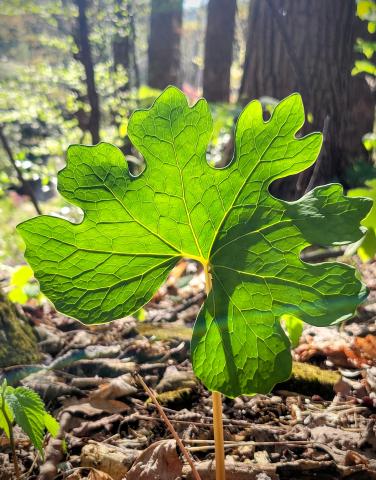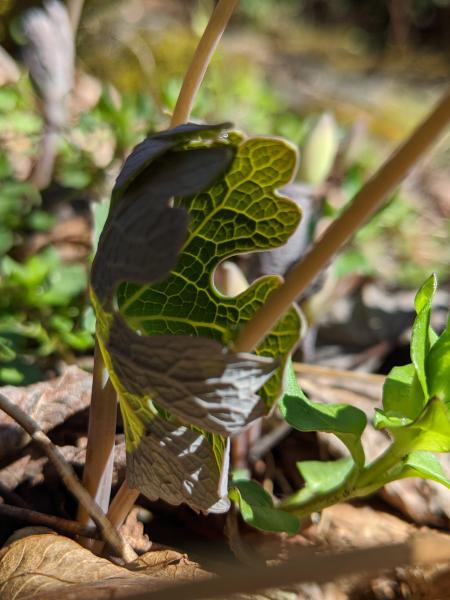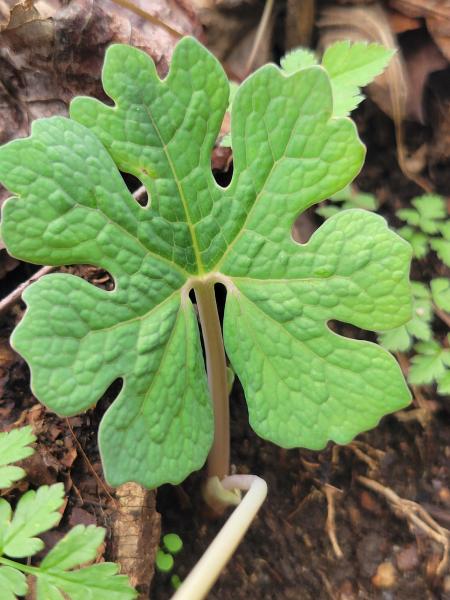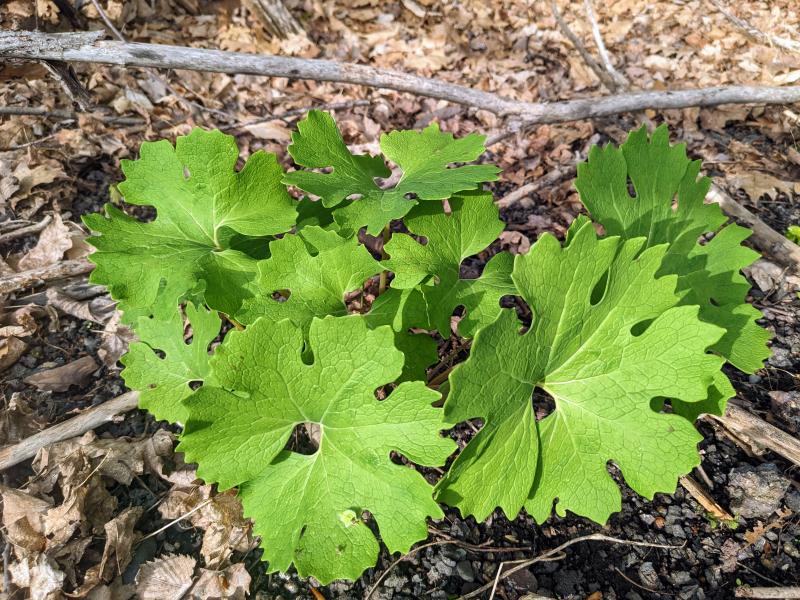
Names and Their Meanings
Bloodroot - Sanguinaria canadensis
Bloodroot
Description
Bloodroot is an herbaceous perennial that is native to Eastern North America. It has a unique leaf unlike any other, being round, deeply lobed and strongly veined. Each above-ground part of the plant has one leaf and one flower that arise on a separate stem, but at first, the leaf completely enwraps the flower. They both arise and unfurl at the same time, and so sometimes the flower opens before the leaf is completely unfurled. The clear white flower has many petals, and a golden orange center; the flower and leaf open with the sun, and close at nighttime. Like other members of the Papaveraceae family, Bloodroot exudes interesting sap, after which this plant is named. The underground stem and root contain red “juice” which exudes when lacerated or broken, so it appears the plant is “bleeding.” Sanguinaria means “bleeding.” Bloodroot grows in undisturbed mixed hardwood mesic forests, on floodplains, and on slopes near streams, rivers, and ponds. Bloodroot prefers rich upland and floodplain orientations, on slopes and in areas with moist to wet soil that is kept that way under layers of deciduous leaf litter.
Conservation Status
S5 (Secure) in Ontario; S4 (Apparently Secure) in New York and Québec
USES
At Six Nations of the Grand River, on January 12th, 1912, John Arthur Gibson told Frederick Wilkerson Waugh about making a dye from bloodroot, indicating that sometimes it’s a trouble to get enough roots to make the red a brilliant color, and that if there’s not a sufficient amount of roots to begin with, the dye will easily fade. He recommends boiling three times, while continuing to add roots, to concentrate the color. On September 8th of 1916, when Mr. Waugh was visiting Wiikwemkoong, Charlie Peasney (whose father was Ojibwe and mother, Oda’wa), relayed that bloodroot could be made into a dye for matting rushes, by boiling the roots in water, then placing the matting rushes in the hot, dyed water.
In 1926-27, Frances Densmore recorded that, among Anishinaabe who she learned from the roots of Sanguinaria were used in combination with Prunus americana (wild plum) bark to make dark red dye. Those two species in combination with Cornus stolonifera (red osier) shavings, and Alnus incana (alder) bark, could also be boiled in one quart of water to dye porcupine quills a brilliant scarlet red. Densmore wrote that the rhizome and roots of bloodroot are irritants and, like other members of the poppy family, narcotic; that a tea made of them is expectorant in small doses, but in large doses nauseant and emetic.
Back at Six Nations of the Grand River, in 1931, Gladys Tantaquidgeon recorded some knowledge from Delaware people who lived at Six Nations of the Grand River, who were part of that community. Tantaquidgeon recorded Bloodroot as being used in the following way: “A small quantity of the powdered root is added to a half a cup of lukewarm water and a teaspoonful administered to stop vomiting. The root is also used in combination with other plants in making a blood purifier.”
For the most part, Bloodroot has historically and is currently used as a source of dye for baskets, fibers, and a source of paint or skin stain. A less frequent use of it is as a medicine, and that is likely because it is easier to collect other plants in sufficient quantities that may produce similar results.






